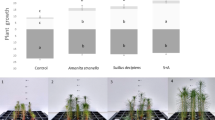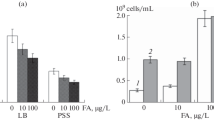Abstract
Plants ofXanthium strumarium L. were inoculated once withPuccinia xanthii Schw. during the 4 leaf stage, others were inoculated 7 times atca. 2 week intervals beginning at the 4 leaf stage, and others were protected from rust infection with regular fungicidal spray applications. Attack byP. xanthii was shown to shorten the plant life cycle and reduce plant growth rate and productivity. Burr production was reduced by up to 59% but percentage seed germination remained unchanged. It was concluded that the overall effects ofP. xanthii, and not reduced burr production alone, may achieve control ofX. strumarium in the field.
Résumé
Des plants deXanthium strumarium L. ont été inoculés une fois au stade 4 feuilles avecPuccinia xanthii Schw, d'autres le furent 7 fois à environ 2 semaines d'intervalle à partir du stade 4 feuilles et d'autres furent protégés contre la rouille par des traitements fongicides. L'attaque parP. xanthii réduit le cycle de développement de la plante, sa croissance et sa productivité. La production de capsules est diminuée jusqu'à 59% mais la faculté germinative des graines n'est pas altérée. On en conclut que l'ensemble des effets deP. xanthii et pas seulement la réduction de production de capsules, peut assurer la lutte contreX. strumarium dans la nature.
Similar content being viewed by others
Références
Alcorn, J. L. — 1975. Rust onXanthium pungens in Australia. —Aust. Plant Pathol. Soc. Newsl., 4, 14–15.
— 1976. Host range ofPuccinia xanthii. —Trans. Br. Mycol. Soc., 66, 365–367.
Arthur, J. C. — 1929. The plant rusts (Uredinales). —John Wiley, N.Y., 446 pp.
Arthur, J. C. &Cummins, G. B. — 1962. Manual of the rusts in United States and Canada. —Hafner Publ. Co, New York.
Everist, S. L. — 1974. Poisonous Plants of Australia. —Angus & Robertson, Sydney.
Hasan, S. — 1974a.Xanthium rust as a possible biological control agent of Bathurst and Noogoora Burrs in Australia. —Proc. 3rd Int. Symp. Biol. Control Weeds, Montpellier, France, 1973, 137–140.
— 1974b. Recent advances in the use of plant pathogens as biocontrol agents of weeds. —PANS 20, 437–443.
Kaul, V. — 1971. Physiological-ecology ofXanthium strumarium Linn. IV. Effect of climatic factors on growth and distribution. —New Phytol., 70, 799–812.
McMillan, C. — 1975. TheXanthium strumarium complexes in Australia. —Aust. J. Bot., 23, 173–192.
Parmelee, J. A. — 1969. The autoecious species ofPuccinia onHeliantheae (‘Ambrosiaceae’) in North America. —Can. J. Bot., 47, 1391–1402.
Parsons, W. T. — 1973. Noxious Weeds of Victoria. —Inkata Press, Melbourne.
Wapshere, A. J. — 1974. An ecological study of an attempt at biological control of Noogoora Burr (Xanthium strumarium). —Aust. J. Agric. Res., 25, 275–292.
Wareing, P. F. &Foda, H. A. — 1957. Growth inhibitors and dormancy inXanthium seed. —Physiol. Plant., 10, 266–280.
Author information
Authors and Affiliations
Rights and permissions
About this article
Cite this article
Julien, M.H., Broadbent, J.E. & Matthews, N.C. Effects ofPuccinia xanthii onXanthium strumarium [Compositae] . Entomophaga 24, 29–34 (1979). https://doi.org/10.1007/BF02377506
Issue Date:
DOI: https://doi.org/10.1007/BF02377506




